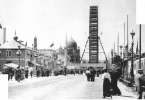While I was strolling through the amazing tulip gardens in Holland, I had felt like I was living during the Tulip Era of the Ottoman Empire. I was able to embrace the traces of my ancestors’ world of pleasure amongst the tulips of Holland, which had extended their heads through their leaves like daggers, displaying coquettishness. If it were possible, I would have never left Holland’s tulip gardens.
The tulip, which had set off on an exciting journey 450 years from here towards Europe, stemmed as a wild flower in the moorlands of Turkistan and travelled to the region of Idil with the Bulgarian Turks, to India with the Timurs, to Iran with the Seljuks, had finally arrived in Anatolia. In the tissue of the tulip bulbs, which were sent to Carolus Clusius in Austria by his friend, the German and Holland ambassador Ogier Ghislain de Busbeck who had come to Istanbul in 1554, they had found the air, water and soil of the moors of Turkistan. Clusius, who had left for Holland to work at Leiden University, became the first person ever to have cultivated and established the industry of tulips within these countries.
There are also records that the interest in the tulip by the Europeans had begun even before this period. During the Near East travels of B. Belon, a French doctor, in 1549, he had stopped by at Istanbul and had mentioned of a “red lily”, which attracted many people to Istanbul who wished to obtain its bulbs.While Conrad Gesner, who claims to have made the tulip popular in Europe, states that he had first come across this flower in 1559, in Ausburg, in the garden of Nerwart, who was known to have a unique collection of exotic flowers. Furthermore, he states that he had also recieved the bulbs from a friend in Istanbul.
In short, the tulip had gone from Istanbul to Europe in the middle years of the 16th century, and with its name “tulip” originating from the Turkish word “tülbent” (a fine head covering), had become a commodity searched for particularly in Holland and Germany. The lack of a tulip collection of an affluent man during the early years of the 17th century was considered to be a sign of dullness. At one stage, the interest in tulip literally became a delirium (tulipo-manie). The rich would boast of the rare tulip bulbs they had owned after having paid high sums of money. There were even some, who would invest all of their fortune, in a tulip bulb. In 1636, there was a sudden increase in the demand for rare tulips and money started to flow into the stock markets in cities like Amsterdam, Rotterdam and Leiden. It came to such a point that some tradesmen would try every means possible to effect the costs in order to make more money and thus, the illness of tulipomanie had become a contagious plague effecting the whole society.
Nevertheless, some tradesmen, who had comprehended the fact that this delirium would not last forever, changed attitude and stopped purchasing new bulbs in order to sell the stocks they had for higher prices. Of course, this led to a great panic leading to the rich tradesmen to suddenly become poor and thus, the delirium had come to an end. While the love for tulips in Turkey, which had exported this passion to Europe during the 16th century, was increasing.
Its for certain that the tulip and tulip culture had surfaced in Anatolia with the Turks. This flower, which the Romans and the Byzantinians were never interested in, had become stylised since the 13th century and surfaced within the ornaments, books and bowls of the Seljuks. It appears in poetry in the 14th century. The tulip, which had become one of the most important symbols of the 15th century, has been likened to blood, candles, wine, cheeks, wounds due to its colour and generally, to a chalice due to its form.
The tulips mentioned within classical poems during the 16th century were surely of the wild kind. As it was wild and bloomed in mountains and hills it was considered “rustic” and spoken of in terms of being shy and mannerless. In one of his gazelles, Necati Bey, a poet from the 15th century, speaks of the tulip as being wretched and helpless as it came to our gardens from the countrysides and that it was banished from the communion of the rose era. While those who studied the tulip from a religious and botanical perspective would read the Beauty of the Lord within it. According to Doctor Mehmed Aşki Efendi, who also has a book titled ‘The Flowers of Fire’ (Mîyârü’l-Ezhar), the tulip owes its high status to the fact that it is written with the word letters of the word “Allah”.
There were many people interested in flowers like the tulip, hyacinths, roses, carnations and daffodils in Istanbul as well as in the other most prominent Ottoman cities. In Istanbul, during the 16th century, where one can final all the classic measurements of the Ottoman culture, the love for gardens and flowers had spread throughout the whole society. Since the era of Selim II, there have been many decrees of orders for tulip and hyacinth bulbs for the palace gardens from the various regions of the Empire. Those apart from the palace, who were also interested in these flowers, would order new bulbs from various locations. The flower had now become an essential part of the daily life. The graceful ones would always give a rose just like Nedim describes in one of his famous gazelles, while young children would always take a bouquet of flowers every morning to their teachers, and the ill would be given elegant glass bottles with carnations, roses, daffodils or tulips in it, wishing them speedy health. Even on the windowsills of the houses of the poor, there would always be roses, geraniums, carnations, fuchsias, and sweet basils. In time, this interest slowly became an art. Hence, we understand with Sultan Ibrahim’s decree that the establishment of an association and experts on flowers were in need. The Sufi commentator, Sarı Abdullah Efendi was brought to the head of this association and was appointed to solve the problems between the cultivators of flowers and the sellers.
During the era of Mehmed IV after Sultan Ibrahim, a botanical research institute by the name of the Assembly of Flower Buds was established and Solakzade Celebi appointed as its leader. The responsibilities of this institute was to evaluate and study the colours, shapes, leaves of tulips that were sent to this institute and, if there were any, to indicate its flaws. Following the fiery discussions taking place amongst flower bowls and bottles, the flower would be given a value of either Highly Distinguished, Medium Distinguised or Outstanding and the flawless tulips would be recorded. Hundreds of these types of tulips would then be given an interesting name like beautiful thunder, unique pearl, twilight prosperity, rose face, silver body, the visible one etc. Sufi Mehmed Dede, one of the companions of Mehmed IV, who was a poet as well as a composer, had a special interest in flowers and one of his main hobbies was to cultivate new kinds, give poetic names and then write poems about them. He has com-piled these poems in his work titled ‘Tuhfetü’l-ihvan’ (Pleasant Friends).
When the Scientist Mehmed Dede had passed away, Ahmed III had been ruling for five years, although the Tulip Era had not begun. After the signing of the Treaty of Passarowitz, Ahmed III, the son of Mehmed IV and Emetullah Gülnuş Sultan, had appointed his son-in-law, Ibrahim Pasha of Nevsehir as the Grand Vizier. The characters of both the Sultan and the Grand Vizier were similar in terms of hating wars, being peaceful and fond of entertainment. Ahmed III, who had experienced the most grand entertainment and festivities during the reign of his father and who procured a taste for art, flowers and gardens, had left himself to the hands of his son-in-law. And thus, the Tulip Era had set off and the already existant interest in tulips in Istanbul had spread throughout and became exaggerated, although it never reached a level like “tulipomanie”.
The Tulip Era was one in which initiations in the fields of construction and restructuring had begun and the doors to the European culture had opened to. The first publishing house was established during this era, a paper factory was founded and a glazed tile factory was built in Istanbul for the purposes of resurrecting the tile glazing in Iznik and Kutahya. On the other hand, the surroundings of the Kagithane stream and the Bosphorus were being ornamented with kiosks, waterfront residences and gardens. The most popular flower in these gardens was the tulip. Ibrahim Pasha of Nevsehir himself was passionately in love with the tulip and this passion showed signs of spreading throughout the society.
Debbagh Ataullah Efendi, known as Tabak Ata, who was one of the scholars of tulip during that era, has shown that the love for tulips was not only limited to the upper societies. In order to have a better understanding of just how the interest in the tulip had spread amongst the society during the era of Ahmed III, it is sufficient to say alone that there were more than one thousand new kinds of tulips developed at the time. Those tulip-lovers, who would work with the scrupulousness of a jeweller, would vehemently compete with one another. The names of the two thousand Turkish tulips and their cultivators have all been recorded within the botanical collection of biographies and tulip journals. Despite the many gleamy and constructive moves, the Tulip Era, which continues to live within the poems of Nedim with all its grandeur, had come to a bloody end with an uprising due to the ecstacy, pleasure and waste of the palace and upper societies which had disturbed the rest of the society. In fact, the interest in tulips continued for a certain amount of time after the Tulip Era. However, with the continuous wars, poverty of the state and society due to the economic crises, the interest in gardens and tulips had started to wear off. The secrets of tulip cultivation of individuals like Sari Abdullah Efendi, the scientist Mehmed Dede and Tabak Ata were all forgotten. The tulips they had cultivated continued to exist on the glazed tiles depicting eternal springs. On the other hand, the people of Holland continued their prosperous lives with the tulip they had taken from the Ottomans more than four hundred years ago.









Leave a Comment